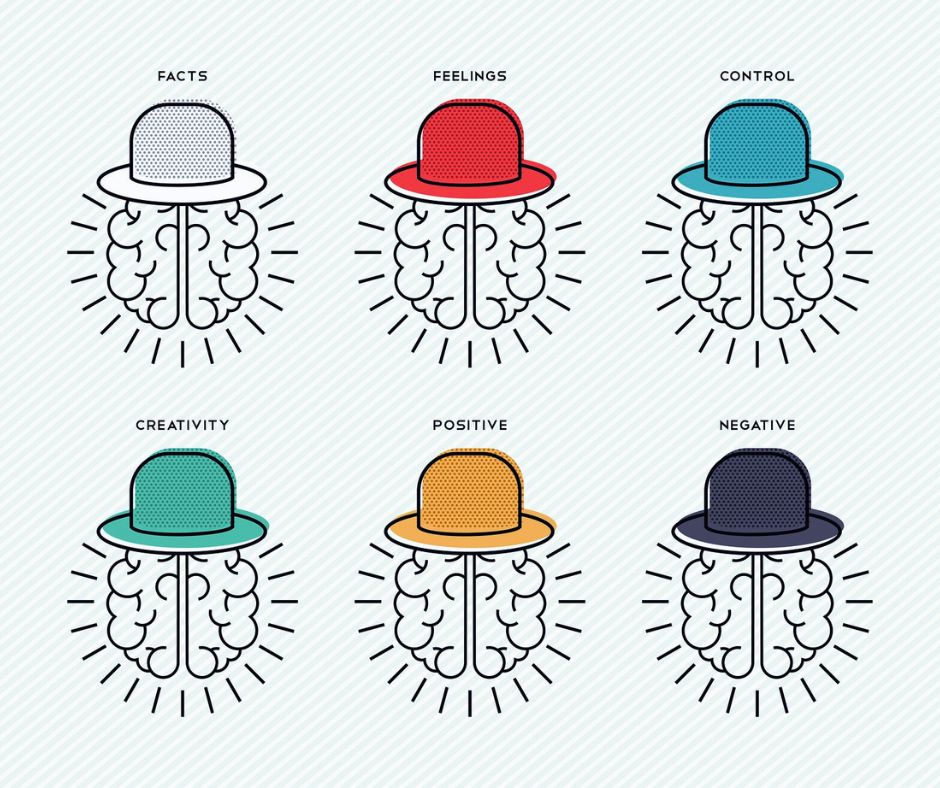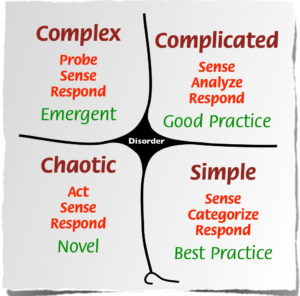Have you ever made a decision, only to regret it later because you didn’t consider all the angles? Maybe you got too excited about the positives and overlooked the potential downsides. Or perhaps you let your emotions cloud your judgment.
We’ve all been there! The good news is that a simple yet powerful tool can help us make better, more well-rounded decisions: the Six Thinking Hats technique.
What are the Six Thinking Hats?
The Six Thinking Hats is a decision-making strategy developed by Edward de Bono, a renowned philosopher, and writer. It’s a simple yet powerful tool that helps us look at a problem or decision from different perspectives, ensuring we don’t miss any crucial angles.
The Colors and Their Meanings
Six different colors represent the Six Thinking Hats, each symbolizing a distinct way of thinking. Here’s what they mean:
1. White Hat 🔘 The White Hat represents an objective, fact-based approach. When wearing this hat, you focus on the data, information, and facts related to the decision at hand.
2. Red Hat 🔴 The Red Hat represents emotion and intuition. It’s about listening to your gut feelings and considering how others might react emotionally to the decision.
3. Black Hat ⚫️ The Black Hat is all about caution and risk assessment. It encourages you to look at the potential downsides, pitfalls, and worst-case scenarios.
4. Yellow Hat 🟡 The Yellow Hat symbolizes optimism and positivity. It’s about identifying the benefits, advantages, and opportunities that the decision might bring.
5. Green Hat 🟢 The Green Hat represents creativity and innovation. It’s about generating new ideas, alternative solutions, and unconventional approaches.
6. Blue Hat 🔵 The Blue Hat is the control hat. It’s about managing the thinking process, ensuring that the other hats are used effectively, and keeping the discussion focused and productive.
How to Use the Six Thinking Hats?
Using the Six Thinking Hats is straightforward. You can either assign different hats to individuals in a group setting or switch between the hats yourself as you consider the decision.
Here’s a step-by-step guide:
- Define the decision or problem you’re trying to solve.
- Start with the White Hat: Gather and analyze all the relevant data and information.
- Move to the Red Hat: Consider your emotions and gut feelings, as well as how others might react emotionally.
- Switch to the Black Hat: Identify potential risks, downsides, and worst-case scenarios.
- Put on the Yellow Hat: Explore the benefits, advantages, and opportunities.
- Try on the Green Hat: Generate new ideas, alternative solutions, and creative approaches.
- Finally, use the Blue Hat to review the thinking process, ensure balanced consideration, and make a final decision.
An Example Scenario
Let’s say you’re a business owner considering launching a new product line. Here’s how you might use the Six Thinking Hats:
White Hat 🔘: Analyze market data, consumer trends, and competition.
Red Hat 🔴: Consider your emotional attachment to the idea and how customers might feel about the new products.
Black Hat ⚫️: Identify risks like production costs, potential lack of demand, or cannibalization of existing products.
Yellow Hat 🟡: Explore opportunities like capturing new market share, increased revenue, and brand growth.
Green Hat 🟢: Brainstorm innovative product features, marketing strategies, or business models.
Blue Hat 🔵: Review all perspectives, ensure balanced consideration, and make a final, well-informed decision.
Benefits of Using the Six Thinking Hats
Using the Six Thinking Hats offers several benefits:
- Balanced Decision Making: By considering multiple perspectives, you’re less likely to overlook crucial factors or make biased decisions.
- Improved Creativity: The Green Hat encourages innovative thinking, leading to more creative solutions.
- Better Risk Management: The Black Hat helps you identify and mitigate potential risks.
- Emotional Intelligence: The Red Hat promotes emotional awareness and consideration of others’ feelings.
- Structured Thinking: The systematic approach keeps discussions focused and productive.
Tips for Effective Use
To get the most out of the Six Thinking Hats, keep these tips in mind:
- Be Disciplined: Stick to the designated hat’s perspective and avoid jumping between hats prematurely.
- Stay Open-Minded: Embrace different viewpoints, even if they challenge your initial assumptions.
- Involve Others: Use the hats in group settings to leverage diverse perspectives and expertise.
- Practice Regularly: The more you use the Six Thinking Hats, the more natural and effective the process will become.
Q&A
Q: Can I use the Six Thinking Hats on my own, or is it only for group settings? A: You can absolutely use the Six Thinking Hats for individual decision-making. Simply switch between the different hats yourself as you consider the problem from various angles.
Q: Is there a specific order I should follow when using the Six Thinking Hats? A: While there’s no strict order, it’s generally recommended to start with the White Hat (facts and data) and end with the Blue Hat (process control). The sequence in between can vary based on your specific situation and preferences.
Q: What if I find it difficult to separate my emotions from the decision-making process? A: That’s precisely why the Red Hat is so valuable. It allows you to acknowledge and consider your emotions in a structured manner, rather than letting them influence your thinking unconsciously.
Q: Can the Six Thinking Hats be used for decisions beyond business or professional settings? A: Absolutely! The Six Thinking Hats is a versatile tool that can be applied to any decision-making process, whether it’s personal, professional, or even creative endeavors like writing or problem-solving.
Q: Is there a time limit or specific duration for using the Six Thinking Hats? A: No, there’s no set time limit. The duration will depend on the complexity of the decision or problem you’re addressing. Some decisions may only require a brief application of the hats, while more complex situations might necessitate a more in-depth exploration of each perspective.





